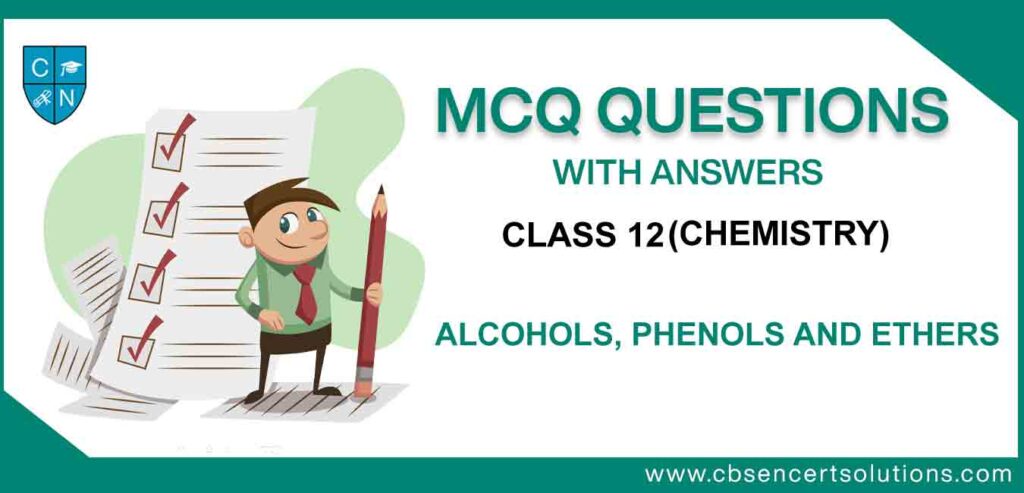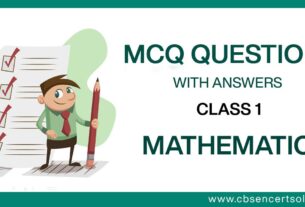Check the below NCERT Alcohols Phenols and Ethers Class 12 MCQ Questions with Answers available with PDF free download. MCQ Questions for Class 12 Chemistry with Answers were prepared based on the latest syllabus and examination pattern issued by CBSE, NCERT and KVS. Our teachers have provided below Alcohols Phenols and Ethers Class 12 Chemistry MCQs Questions with answers which will help students to revise and get more marks in exams
Alcohols Phenols and Ethers Class 12 MCQ Questions with Answers
Refer below for Alcohols Phenols and Ethers Class 12 MCQ Questions with solutions. Solve questions and compare with the answers provided below
Alcohols Phenols and Ethers Class 12 MCQ Questions
Question. Lucas reagent is
(a) conc. HCl and anhydrous ZnCl2
(b) conc. HNO3 and hydrous ZnCl2
(c) conc. HCl and hydrous ZnCl2
(d) conc. HNO3 and anhydrous ZnCl2.
Answer
A
Question. Methanol is industrially prepared by
(a) oxidation of CH4 by steam at 900ºC
(b) reduction of HCHO using LiAIH4
(c) reaction of HCHO with a solution of NaOH
(d) reduction of CO using H2 and ZnO–Cr2O3
Answer
D
Question. The major products C and D formed in the following reactions respectively are
H3C−CH2−CH2−O−C(CH3)3 excess HI C + D
(a) H3C−CH2−CH2−I and I−C(CH3)3
(b) H3C−CH2−CH2−OH and I−C(CH3)3
(c) H3C−CH2−CH2−I and HO−C(CH3)3
(d) H3C−CH2−CH2−OH and HO−C(CH3)3
Answer
A
Question. The heating of phenyl methyl ether with HI produces
(a) iodobenzene
(b) phenol
(c) benzene
(d) ethyl chloride.
Answer
B
Question. Among the following sets of reactants which one produces anisole?
(a) CH3CHO ; RMgX
(b) C6H5OH ; NaOH ; CH3I
(c) C6H5OH ; neutral FeCl3
(d) C6H5CH3 ; CH3COCl ; AlCl3
Answer
B
Question. The major organic product in the reaction is
CH3 – O – CH(CH3)2 + HI products
(a) CH3I + (CH3)2CHOH
(b) CH3OH + (CH3)2CHI
(c) ICH2OCH(CH3)2
(d) CH2OC(CH3)2
Answer
A
Question. Ethyl chloride is converted into diethyl ether by
(a) Perkins reaction
(b) Grignard reaction
(c) Wurtz synthesis
(d) Williamson’s synthesis.
Answer
D
Question. Which one of the following compounds is resistant to nucleophilic attack by hydroxyl ions?
(a) Diethyl ether
(b) Acetonitrile
(c) Acetamide
(d) Methyl acetate
Answer
A
Question. The compound which does not react with sodium is
(a) CH3COOH
(b) CH3CHOHCH3
(c) C2H5OH
(d) CH3OCH3
Answer
D
Question. Which one is formed when sodium phenoxide is heated with ethyl iodide?
(a) Phenetole
(b) Ethyl phenyl alcohol
(c) Phenol
(d) None of these
Answer
A
Question. Intermolecular hydrogen bonding is strongest in :
(a) Methylamine
(b) Phenol
(c) Formaldehyde
(d) Methanol
Answer
D
Question. Propan-1-ol can be prepared from propene by :
(a) H2O / H2SO4
(b) Hg(OAc)2 / H2O followed by NaBH4
(c) B2H6 followed by H2O2
(d) CH3CO2H/H2SO4
Answer
A
Question. Among the following the one which reacts most readily with ethanol is
(a) p-nitrobenzyl bromide
(b) p-chlorobenzyl bromide
(c) p-methoxybenzyl bromide
(d) p-methylbenzyl bromide
Answer
D
Question. The most suitable reagent for the conversion of RCH2OH → RCHO is :
(a) KMnO4
(b) K2Cr2O7
(c) CrO3
(d) PCC (pyridine chlorochromate)
Answer
C
Question. Lucas reagent is:
(a) anhy. AlCl3 + conc. HCl
(b) anhy. AlCl3 + conc.HNO3
(c) anhy. ZnCl2
(d) anhy. ZnCl2 + conc. HCl
Answer
Question. When o- or p -phenol sulphonic acid is treated with bromine water, the product formed is
(a) 2, 4-dibromophenol
(b) 2, 4, 6-tribromophenol
(c) 3-bromophenol boric acid
(d) 3, 5-dibromophenol
Answer
B
Question. The final product of the following reaction is/are

Answer
B
Question. Phenol on heating with CCI4 and aqueous KOH gives salicylic acid. This reaction is
(a) Friedel-Craft reaction
(b) Diels-Alder reaction
(c) Reimer-Tiemann reaction
(d) Wittig reaction
Answer
C
Question. Among the following, which is least acidic?
(a) phenol
(b) o-cresol
(c) p -nitrophenol
(d) p -chlorophenol
Answer
B
Question. An organic compound ‘X’ with molecular fommla, C7H8O is insoluble in aqueous NaHCO3 but dissolves in NaOH. When treated with bromine water’ X’rapidly gives ‘Y’ C7H5OBr3 .
The compounds’ X’ and’ Y’ respectively, are
(a) benzyl alcohol and 2, 4, 6-tribromo-3-methoxy benzene
(b) benzyl alcohol and 2, 4, 6-tribromo-3-methyl phenol
(c) o-cresol and 3, 4, 5-tribromo-2-methyl phenol
(d) methoxybenzene and 2, 4, 6-tribromo-3-methoxy benzene
(e) m-cresol and 2, 4, 6-tribromo-3-methyl phenol
Answer
E
Question. Benzoylation of phenol in alkaline medium is known as
(a) Friedel-Crafts reaction
(b) Wurtz-Fittig reaction
(c) Schotten-Baurnann reaction
(d) Sabatier Senderens reduction
Answer
C
Question. By heating phenol with chloroform in alkali, it is converted into
(a) salicylic acid
(b) salicylaidehyde
(c) anisole
(d) phenyl benzoate
Answer
B
Question. C2H5O Hand C6H5OHcan be distinguished by
(a) Br2 + H2O
(b) FeCI3
(c) I2 + NaOH
(d) Both (b) and (c)
Answer
D
Question. Phenol is more acidic than alcohol because
(a) phenol is more soluble in polar solvents
(b) alcohol does not lose hydrogen atom
(c) phenoxide ion is stabilised by resonance
(d) phenoxide ion doesn’t exhibit resonance
Answer
C
Question. Picric acid is a stronger acid than acetic acid and benzoic acid. It contains
(a) —SO3H group
(b) two—COOH groups
(c) phenolic group
(d) three—COOH groups
Answer
C
Question. The following reaction is known as

(a) Perkin reaction
(b) Gattermann reaction
(c) Kolbe reaction
(d) Gattermann-a.ldehyde reaction
Answer
D
Question. Which of the following compound would not evolve CO2 when treated with NaHCO3 solution?
(a) Salicylic acid
(b) Phenol
(c) Benzoic acid
(d) 4-nitrobenzoic acid
Answer
B
Question. CH3OC2H5 and (CH3)3 C – OCH3 are treated with hydroiodic acid. The fragments obtained after reactions are
(a) CH3I + HOC2H5; (CH3)3 Cl + HOCH3
(b) CH3OH + C2H5I; (CH3)3 Cl + HOCH3
(c) CH3OH + C2H5I; (CH3)3COH + CH3I
(d) CH3I + HOC2H5; CH3I + (CH3)3 COH.
Answer
D
Question. Which of the following is a primary halide?
(a) Iso-propyl iodide
(b) Secondary butyl iodide
(c) Tertiary butyl bromide
(d) Neohexyl chloride
Answer
A
Question. An organic compound X on treatment with pyridinium chlorochromate in dichloromethane gives compound Y. Compound Y reacts with I2 and alkali to form triiodomethane. The compound ‘X’ is
(a) C2H5OH
(b) CH3CHO
(c) CH3COCH3
(d) CH3COOH
Answer
C
Question. The formation of diethyl ether from ethanol is based on :
(a) Dehydrogenation reaction
(b) Hydrogenation reaction
(c) Dehydration reaction
(d) Heterolytic fission reaction
Answer
D
Question. Chloropicrin is obtained by the reaction of
(a) steam on carbon tetrachloride
(b) nitric acid on chlorobenzene
(c) chlorine on picric acid
(d) nitric acid on chloroform
Answer
A
Question. Ethanol can be prepared more easily by which reaction ?
(i) CH3CH2Br + H2O → CH3CH2OH
(ii) CH3CH2Br + Ag2O (in boiling water)→ CH3CH2OH
(a) by (i) reaction
(b) by (ii) reaction
(c) Both reactions proceed at same rate
(d) by none
Answer
C
Question. An aromatic ether is not cleaved by HI even at 525 K. The compound is
(a) C6H5OCH3
(b) C6H5OC6H5
(c) C6H5OC3H7
(d) Tetrahydrofuran
Answer
D
Question. Ethanol when reacted with PCl5 gives A, POCl3 and HCl. A reacts with silver nitrite to form B (major product) and AgCl. A and B respectively are
(a) C2H5 C l and C2H5OC2H5
(b) C2H6 and C2H5OC2H5
(c) C2H5 C l and C2H5NO2
(d) C2H6 and C2H5NO2
Answer
B
Question. Polyvinylalcohol can be prepared by
(a) polymerization of vinyl alcohol
(b) alkaline hydrolysis of polyvinyl acetate
(c) polymerization of acetylene
(d) reaction of acetylene with H2SO4 in presence of HgSO4
Answer
A
Question. Which of the following fact(s) explain(s) as to why p-nitrophenol is more acidic than phenol?
I. –I Effect of nitro group.
II. Greater resonance effect of p-nitrophenoxy group
III. Steric effect of bulky nitro group
(a) I and II
(b) I and III
(c) II and III
(d) II alone
Answer
D
Question. ClCH2CH2OH is stronger acid than CH3CH2OH because of:
(a) – I effect of Cl increases negative charge on O atom of alcohol
(b) – I effect of Cl disperses negative charge on O atom to produce more stable cation
(c) – I effect of Cl disperses negative charge on O atom to produce more stable anion
(d) None of these
Answer
D
Question. The ether that undergoes electrophilic substitution reactions is
(a) CH3OC2H5
(b) C6H5OCH3
(c) CH3OCH3
(d) C2H5OC2H5
Answer
A
Question. A triglyceride can have how many different acyl groups?
(a) 3
(b) 2
(c) 1
(d) 4
Answer
C
Question. In the Victor-Meyer’s test, the colour given by 1°, 2° and 3° alcohols are respectively.
(a) red, colourless, blue
(b) red, blue, colourless
(c) blue, red, violet
(d) red, blue, violet.
Answer
A
Question. Which one of the following is not formed when glycerol reacts with HI ?
(a) CH3 — CHI — CH3
(b) CH3 — CH = CH2
(c) CH2OH — CHI — CH2OH
(d) CH2 = CH — CH2I
Answer
C
Question. The reaction of Lucas reagent is fastest with:
(a) (CH3)2CHOH
(b) CH3(CH2 )2OH
(c) CH3CH2OH
(d) (CH3)3COH
Answer
D
Question. Following compounds are given:
(i) CH3CH2OH (ii) CH3COCH3
(iii) CH3 – CHOH
Í
CH3
(iv) CH3OH
Which of the above compound(s), on being warmed with iodine solution and NaOH, will give iodoform?
(a) (i) and (ii)
(b) (i), (iii) and (iv)
(c) (i) only
(d) (i), (ii) and (iii)
Answer
D
Question. Ethanol when reacted with PCl5 gives A, POCl3 and HCl. A reacts with silver nitrite to form B (major product) and AgCl. A and B respectively are
(a) C2H5 Cl and C2H5OC2H5
(b) C2H6 and C2H5OC2H5
(c) C2H5Cl and C2H5NO2
(d) C2H6 and C2H5NO2
Answer
C
Question. Phenol on reaction with Br2 in non-polar aprotic solvent furnishes
(a) 2, 4, 6-tribromophenol
(b) p-bromophenol
(c) o- and p-bromophenol
(d) m-bromophenol
Answer
C

We hope you liked Alcohols Phenols and Ethers Class 12 MCQ Questions with answers provided above. In case you have any questions please post them in the comments section below and our Chemistry teachers will provide a response.

